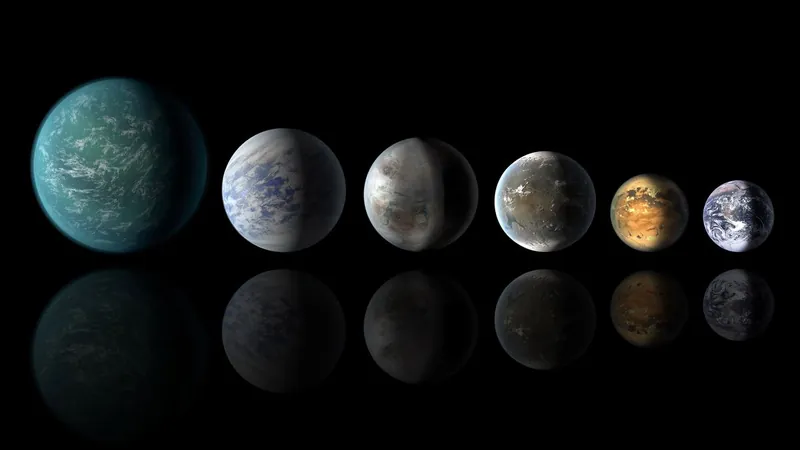
Unveiling the Mysteries: The Key Differences Between Young and Old Exoplanets
2025-04-03
Author: Ken Lee
Introduction
Astronomers are on the brink of discovering groundbreaking insights about exoplanet evolution through a revolutionary study that compares young and older exoplanets. This research could hold the answers to some of astronomy's most puzzling questions, including the enigmatic "hot Neptune desert," which refers to the notable absence of Neptune-sized planets in close orbits to their stars, and the intriguing "radius valley," where a distinct gap exists between planets about 1.5 to 2 times the size of Earth.
Observational Techniques
By observing young exoplanets in their primordial phase, researchers can glimpse the formative stages of planetary development, prior to the extensive atmospheric changes that older planets experience. The impressive capabilities of wide-field, high-precision transit surveys, including NASA's Kepler and TESS missions, allow scientists to collect these essential observations. Through these surveys, astronomers can analyze distant worlds millions and even billions of light-years away, using sophisticated methods that detect tiny dips in stellar brightness as planets transit in front of their stars.
Challenges in Studying Young Planets
However, studying young planets poses unique challenges. "Our ability to detect and observe young planets is often limited by how 'quiet' the planet’s host star is," explained Galen Bergsten, a Ph.D. candidate at the University of Arizona. Young stars tend to be quite noisy, making it difficult to discern the subtle signals of their orbiting planets. Despite these challenges, exciting findings are emerging.
Research Findings
Researchers, including Rachel Fernandes from Penn State University, have focused on exoplanets with short orbital periods, around 12 days. They have discovered two significant evolutionary changes: planets tend to shrink over time as they lose their atmospheres and migrate inward towards their host stars due to gravitational interactions. Understanding these processes is crucial for grasping the dynamics of planetary evolution.
Categories of Exoplanets
The study categorized the subjects into two age groups: young planets, aged between 10 million and 100 million years, and intermediate-aged planets, 100 million years to 1 billion years. Utilizing data from NASA's TESS for young planets and Kepler for older ones, the researchers found that young planets were surprisingly more abundant.
Implications of Atmospheric Loss
"The higher occurrence rate of young planets indicates that these bodies may be shrinking over time,” Bergsten noted. "In the early stages of their formation, smaller planets were quite common, yet they tend to cool down and lose atmospheric mass, making them harder to detect in later stages." This atmospheric loss is particularly critical for planets in close proximity to their stars, where intense radiation can strip away their gaseous envelopes. "We see fewer large sub-Neptunes around older stars because many have lost significant portions of their atmospheres and cooled down," Fernandes elaborated.
Role of Tidal Migration
Moreover, the research highlights the crucial role of tidal migration— a phenomenon where planets slowly spiral inward due to their host star's gravitational pull. This inward migration is vital to understand as it explains the prevalence of short-period planets in close orbits.
Future Prospects
As our observational capabilities improve with future missions like NASA's Roman, ESA's PLATO, and Gaia, we anticipate a treasure trove of data that could revolutionize our knowledge of planetary systems. “Everything we know about planets is based on fewer than 6,000 exoplanets discovered thus far,” Fernandes remarked. “In the coming decades, we’ll likely uncover tens to hundreds of thousands more, which will dramatically enhance our understanding of planet formation and evolution.” With these upcoming missions promising to provide refined data on exoplanets, especially those farther from their stars, researchers are excited about a new era of possibility in exoplanet study. The next few decades will undoubtedly bring spectacular advances in unraveling the mysteries of our universe—so stay tuned, as the cosmos has many more secrets waiting to be revealed!



 Brasil (PT)
Brasil (PT)
 Canada (EN)
Canada (EN)
 Chile (ES)
Chile (ES)
 Česko (CS)
Česko (CS)
 대한민국 (KO)
대한민국 (KO)
 España (ES)
España (ES)
 France (FR)
France (FR)
 Hong Kong (EN)
Hong Kong (EN)
 Italia (IT)
Italia (IT)
 日本 (JA)
日本 (JA)
 Magyarország (HU)
Magyarország (HU)
 Norge (NO)
Norge (NO)
 Polska (PL)
Polska (PL)
 Schweiz (DE)
Schweiz (DE)
 Singapore (EN)
Singapore (EN)
 Sverige (SV)
Sverige (SV)
 Suomi (FI)
Suomi (FI)
 Türkiye (TR)
Türkiye (TR)
 الإمارات العربية المتحدة (AR)
الإمارات العربية المتحدة (AR)